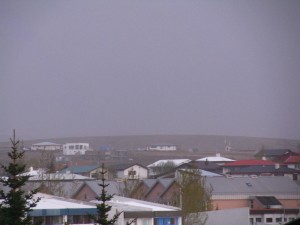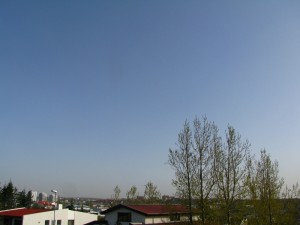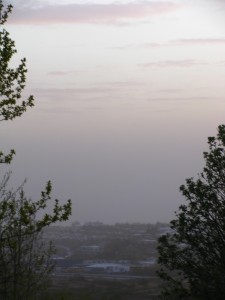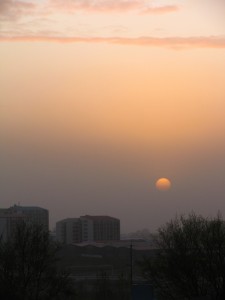Greetings from the Grímsvatn volcano. Posted by hulda on May 23, 2012 in Icelandic culture, Icelandic customs
 It began by somewhat of a surprise around seven o’clock in the evening of Monday, 21st May. As I stood at the bus stop waiting for my bus to come and take me downtown for a choir meeting I noticed something odd about the way the air looked like over the city.
It began by somewhat of a surprise around seven o’clock in the evening of Monday, 21st May. As I stood at the bus stop waiting for my bus to come and take me downtown for a choir meeting I noticed something odd about the way the air looked like over the city.
Although fog is quite usual in the Reykjavík area the day was rather too sunny for it to be that. Besides that the colour of the mist was strange to say the least. It was sickly yellow and lay heavily near the ground, covering the mountain Esja so well it was almost out of view. It looked familiar, so familiar in fact that I made a very quick guess to what it was and it turned out I was correct. It was ash mist, öskumistur. I had been in it once before, last year when Grímsfjall erupted.
 To explain a bit better, ash mist occurs often a year or even years after the original eruption took place. The ash, being very fine and light, often lies on top of the ground and a suitable wind can easily pick it up and carry it on. Last year’s ash mist was a large part Eyjafjallajökull eruption ash and part fresh Grímsfjall ash, this year’s was mostly Grímsfjall with a touch of Eyjafjallajökull. The difference is in the type: Eyjafjallajökull ash was black in colour, Grímsfjall yellow, and that’s an easy way of telling them apart. Besides this Eyjafjallajökull ash was light and took much longer to fall. This recent one was over with one rain and one night.
To explain a bit better, ash mist occurs often a year or even years after the original eruption took place. The ash, being very fine and light, often lies on top of the ground and a suitable wind can easily pick it up and carry it on. Last year’s ash mist was a large part Eyjafjallajökull eruption ash and part fresh Grímsfjall ash, this year’s was mostly Grímsfjall with a touch of Eyjafjallajökull. The difference is in the type: Eyjafjallajökull ash was black in colour, Grímsfjall yellow, and that’s an easy way of telling them apart. Besides this Eyjafjallajökull ash was light and took much longer to fall. This recent one was over with one rain and one night.
 The ash isn’t outright dangerous to anyone except for people with asthma or other type of respiratory illnesses, at least not in the amounts that we received on Monday. Nevertheless it’s not healthy either, and people tend to avoid going outdoors during it. Other than that there’s very little that can be done while waiting for the ash to fall except for following the news on the television, radio or the internet and acting according to the recommendations. Windows can be taped shut to help keep the ash outside and if the mist gets too thick, masks can be worn outdoors.
The ash isn’t outright dangerous to anyone except for people with asthma or other type of respiratory illnesses, at least not in the amounts that we received on Monday. Nevertheless it’s not healthy either, and people tend to avoid going outdoors during it. Other than that there’s very little that can be done while waiting for the ash to fall except for following the news on the television, radio or the internet and acting according to the recommendations. Windows can be taped shut to help keep the ash outside and if the mist gets too thick, masks can be worn outdoors.
It should be noted too that the ash is often acidic in quality, which means that letting it sit on your car for a long time will make it rust quickly. Therefore you’ll see people washing their cars a lot when this happens, and there’s the other damage that the ash can do. As it consists mostly of tiny glass particles it can only be washed out with a lot of water, scrubbing must be avoided at all costs or else the car, or any other object that needs a clean up, will be scratched beyond imagination.
 All the photos in this entry have been taken during a couple of hours – approximately three, if I remember correctly – in that one night to give a better idea how fast the ash moves. The sunset that night was rather spectacular, I must say! Right now it’s thankfully over, the air is clear once more, Esja in full sight and lots of car- and yard washing is taking place along our street. Until the next one arrives we can once again forget about the volcanoes.
All the photos in this entry have been taken during a couple of hours – approximately three, if I remember correctly – in that one night to give a better idea how fast the ash moves. The sunset that night was rather spectacular, I must say! Right now it’s thankfully over, the air is clear once more, Esja in full sight and lots of car- and yard washing is taking place along our street. Until the next one arrives we can once again forget about the volcanoes.
News in Icelandic about the ash mist:
Gríðarlegt öskumistur á Suðurlandi
Vilja rigningu til að skola Grímsvatnaöskunni burt (note that the photo accompanying this news piece is from the last year – it was not quite this bad this time)

Build vocabulary, practice pronunciation, and more with Transparent Language Online. Available anytime, anywhere, on any device.
About the Author: hulda
Hi, I'm Hulda, originally Finnish but now living in the suburbs of Reykjavík. I'm here to help you in any way I can if you're considering learning Icelandic. Nice to meet you!



